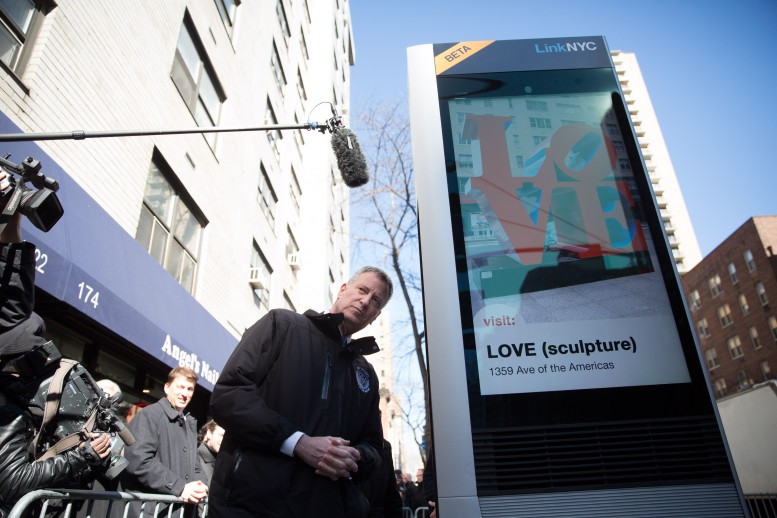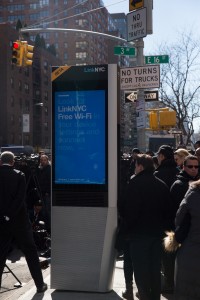Perhaps you’ve noticed or heard about the new public Wi-Fi kiosks being installed around the city, often replacing payphones? Well, they’re called Links (the operation is LinkNYC) and the plan is for many many more. Before they are installed in historic districts, the Landmarks Preservation Commission must rule, and a public hearing on the issue was held Tuesday.
The Links generate a free wireless internet signal, but also feature a tablet, on which you can get directions or make free phone calls to anywhere in the United States, including, of course, 311, 911, and 411, and have charging ports for your mobile devices. They also have digital advertising. In addition to that model, there is also a model without digital advertising, and it has a smaller profile.
There are already rules governing where new payphones can be installed, and that is the starting point for where these new kiosks can be installed. But there are further proposed rules involving their installation in historic districts or near landmarks. If the LPC agrees to those rules, the installation of individual kiosks, if they meet the Public Design Commission’s criteria, will not need approval of the full LPC each time.
Some of those rules include that there would only be one kiosk per location. There used to be plenty of places in the city with multiple phones in one spot. That would not be allowed with these new kiosks. There would be a minimum distance between them. No new ones would be allowed on historic pavement or in front of individual landmarks. LPC general counsel Mark Silberman said it’s estimated that one-quarter of existing payphones will not be replaced by Links in their current locations.
Jennifer Hensley, representing CityBridge, the consortium behind LinkNYC, noted that there are no flat surfaces to collect garbage and that Long Island City-based staff will inspect each unit twice a week to ensure they are in good working order, as the units will be exposed to the elements more so than telephone booths.
Public testimony was mixed.
The Greenwich Village Society for Historic Preservation’s Sarah Bean Apmann said her organization was concerned about what it would be like if the kiosks were installed to their maximum allowable density.
Christabel Gough of the Society for the Architecture of the City said it was pointless to leave this to the PDC because every installation is different and should be evaluated in its context.
Sean Khorsandi of Landmark West! objected to adopting the citywide rule, calling saying the size of the kiosks and their existence at all is based on advertising, not providing Wi-Fi. He said it’s a case of the “tail wagging the dog.” He noted that many church’s have integrated cellular repeaters into their steeples (often to the financial benefit of the church) and that Wi-Fi devices could be integrated into existing lampposts, which would give greater height and coverage. “Can you hear me now?” he asked, rhetorically.
Tara Kelly of the Municipal Art Society said she found the devices and process appropriate because the process would be similar to that for payphones.
“The Municipal Art Society of New York finds the proposed rules amendment to be appropriate. The standards for the approval of the installation of public communications structures (PCS) are similar to the existing approval for public pay telephones (PPT),” Kelly testified. “In fact, PCS devices will replace existing PPT locations offering free rather than paid phone service. In the instance where a new location is desired, it will be presented to the local Community Board for review. The PCS kiosks will not be installed in historic paving or directly in front of individual landmark buildings, and advertising panels are prohibited in residential districts.”
Elizabeth Fagen of Friends of the Upper East Side Historic Districts was not supportive of the rule or design, saying they are “much larger and more intrusive than payphones.” “[Each kiosk] detracts from [the] streetscape,” she said.
Judy Stanton of the Brooklyn Heights Association said she was “very concerned” and wanted these kiosks banned from purely residential streets.
The Historic Districts Council’s Kelly Carroll has concerns as well. Here is her testimony.
“The Historic Districts Council is pleased that the Commission offered the opportunity for the public to speak on the issue of wifi kiosks to set standards for their appropriateness in historic districts. In general, we believe that the rules before the Commission today do not go far enough to protect New York’s historic districts from the dominating presence of these very large fixtures. We fear that by allowing the kiosks to be easily approved at staff level, many will appear in our historic districts without a full understanding of their impact, as no sample of what the historic district kiosks will look like, or whether they have illuminated screens or not. Assuming that historic districts kiosks remain without advertising, do they still have to be so large?”
“One section not included in these rules should address the issue of a minimum sidewalk width for the placement of kiosks. Commercial streets in historic districts often have narrow sidewalks, which can be easily overwhelmed. Examples are portions of Lexington Avenue and the entire length of Madison Avenue in the Upper East Side Historic District. Cluttered sidewalks throughout New York City create a disservice to pedestrians. In our historic districts, these could produce the additional problem of detracting from the neighborhood architecture. We ask that the Commission develop standards in addition to those set forth by the Department of Transportation and DOITT to ensure that the wifi kiosks are not placed on narrow sidewalks.”
Lo van der Valk of Carnegie Hill Neighbors expressed “reservations,” saying the kiosks are “quite noticeable and will impact the sense of place.” He suggested reducing the brightness at night, possibly also during the winter, and having the digital advertising space not only show advertising, but also images of the historic district it occupies.
While Commissioner Michael Devonshire asked a technical question, that lead to the information about the frequency of inspection, there was no discussion among or vote by the commissioners. That is to be expected when the LPC next takes up the issue. When that will be is not currently known.
Subscribe to YIMBY’s daily e-mail
Follow YIMBYgram for real-time photo updates
Like YIMBY on Facebook
Follow YIMBY’s Twitter for the latest in YIMBYnews



For convenience with wireless internet at first, run quickly more than telephone booth.
Most of the complaints sound like bunk to me, and I say that as someone who owns a designated historic property and cares deeply about historic buildings and neighborhoods.
The exceptions are the sidewalk width and ad screen brightness issues. Those warrant a closer look, IMHO.
Is there any need for them to be so large? They could easily be the size of a mailbox.
I love them! Super convenient and great for calls and charging
These are glorified billboards run in part by Titan Advertising Group, supposedly the world’s biggest outdoor advertising company.
Those screens could/will be used to display important information in addition to ads. Let’s hope that the Lankmarkers don’t restrict the digital screens. Entire areas would loose out.